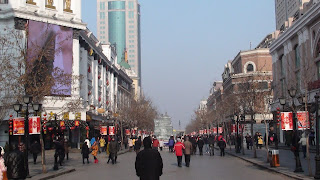Saturday February 4, 2012
 |
| Street sign, Harbin. |
Big fur hats, cobblestone streets, 19th century street lamps, Cyrillic signs, grand Art Nouveau buildings, and a city park named after Stalin. One would think we're in the Soviet Union, but we're sixty years and six thousand kilometres from Stalinist Moscow. I'm in Harbin, in the region of China historically known as Manchuria.
Harbin was a small village until the Russians built a railway through here in 1898 for a shorter route to Vladivostok. After the socialist revolution in Russia this city absorbed a large group of White Russian refugees, and became the biggest populace of Russians outside the Soviet Union. People from other eastern European countries also migrated here in the early 20th century - the 1913 census showed over fifty nationalities being represented. The city became the gateway through which western goods and trends arrived in China.

With such a cosmopolitan background the architecture is fascinating. And unusually for a Chinese city Harbin is very proud of its foreign heritage, with the local authorities very protective of the old buildings and streetscape against the pressures of modern development.
At the old part of Harbin - also the main tourist/shopping strip - one cannot turn anywhere without seeing gorgeous Russian-era buildings. Art nouveau and art deco are both well represented, along with pseudo-Baroque frontages.
 |
| A business must diversify to thrive. |
The street itself is a charming sight with cobblestone, Victorian street lamps, signage in Cyrillic and is pedestrian only, in the purest sense - the one part of China without bicycles or cars to mow you down! There is an endless number of Russian souvenir shops selling not just the predictable Matryoshka dolls and tea sets, but bizarre items like massive busts of Lenin and menacing knives you could never hop on a plane with in this day and age.
At the northern end of the main street overlooking the Songhua River is Stalin Park. Russians stopped naming things after Stalin fifty years ago! And the White Russians came to Harbin to escape the Communists! One would guess the park was named by the Chinese Harbinites.
 |
| Harbin: A Jewish wedding, 1930s. |
There was a significant Jewish community in this city - initially amongst the Russian immigrants, and later from Germans fleeing Nazi persecution. The New Synagogue now hosts a very good museum depicting their life in Harbin, where the Chinese proudly declare their role in providing the "wandering peoples" a safe home. The Old Synagogue has also been preserved, currently used as a hostel. A large Jewish cemetery still exists in the suburbs, and has regularly hosted Israeli dignitaries and visitors.
Many of the Orthodox churches have disappeared but the impressive St Sofia in the centre of the city is still standing as Harbin's premier tourist attraction. Fittingly the building now houses an architecture museum/gallery. St Sofia is now accompanied by a large European style square, the site and church having been renovated in the 1990s.
 |
| Harbin: St Sofia Orthodox Church |
A couple of mosques remain in Harbin - I visited the Turkish one in the middle of old town which has been long abandoned.

At the end of World War II the USSR took back Harbin from the occupying Japanese, and briefly administered it before handing over to Communist China. Under Soviet administration many Russian Harbinites were forcibly repatriated (to labour camps). Some, along with the other Europeans, fled to countries like Australia and the United States. I was told back in Australia that almost all people of Harbin heritage you'd meet in Sydney are Caucasian.
After my lukewarm impression of Beijing in 2010 the rich mix of cultures in Harbin has charmed and restored my faith in Chinese cities.
 With such a cosmopolitan background the architecture is fascinating. And unusually for a Chinese city Harbin is very proud of its foreign heritage, with the local authorities very protective of the old buildings and streetscape against the pressures of modern development.
With such a cosmopolitan background the architecture is fascinating. And unusually for a Chinese city Harbin is very proud of its foreign heritage, with the local authorities very protective of the old buildings and streetscape against the pressures of modern development.

 With such a cosmopolitan background the architecture is fascinating. And unusually for a Chinese city Harbin is very proud of its foreign heritage, with the local authorities very protective of the old buildings and streetscape against the pressures of modern development.
With such a cosmopolitan background the architecture is fascinating. And unusually for a Chinese city Harbin is very proud of its foreign heritage, with the local authorities very protective of the old buildings and streetscape against the pressures of modern development.



There was a disappointing lack of polio coverage in this post.
ReplyDeleteHa ha ha ha, I'll try to add more pathology into future articles.
ReplyDelete